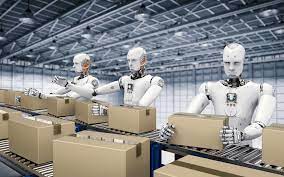The head of the grinding unit at S&D Blech, a manufacturer of machine parts, is retiring. The corporation will replace him with a robot because there aren’t many candidates for the skilled but risky and dirty manual tasks due to Germany’s severe labor crisis.
As the labor shortage in Germany increases due to the post-war “baby boom” generation’s steady departure from the workforce, smaller and medium-sized businesses are resorting to automation.
Official statistics from June indicate that there were almost 1.7 million vacant jobs in Germany. Nearly 100 billion euros ($109 billion) in annual growth in Europe’s largest economy is thought to be lost because over half of businesses find it difficult to fill open positions, according to the German Chambers of Commerce and Industry.
Henning Schloeder, managing director, used this tendency as justification for S&D Blech’s push for automation and digitalization during the past few years, stating that “this will further aggravate the already difficult skilled labor situation, particularly in production and crafts.”
It was difficult to find a new head of the grinding unit, Schloeder told reporters, “not only because of all the experience he has, but also because it’s a back-breaking job that no one wants to do anymore”.
The high heat and constant loudness of machine grinding might be hazardous due to the sparks they produce.
A rise in immigration and the number of working women in Germany have helped offset recent demographic shifts.
However, because of the low birth rate and the retirement of baby boomers, a substantially smaller new generation is entering the workforce, and the Federal Employment Agency projects that the labor pool will contract by 7 million individuals by 2035.
Nela Richardson, chief economist at global payrolls and HR services provider ADP, stated that the influence of advanced automation technologies, from robotics to AI, will be widely felt with comparable trends affecting other developed economies.
“All those advances have the potential to revolutionize the workplace in the long run. Everybody will approach their work in a unique way,” she said to reporters.
Germany currently holds the top spot in Europe and ranks fourth globally for robot sales because of significant investments made in automation by major automakers and other industrial conglomerates.
However, as robots get more affordable and simpler to use, the Mittelstand businesses—manufacturers like S&D Blech, bakeries, laundries, and supermarkets—that comprise the backbone of the nation’s economy are also utilizing them.
The International Federation of Robotics reports that about 26,000 robots were deployed in Germany last year; this number was only exceeded in 2018, just before the COVID-19 epidemic halted the industry’s previously normal 4% yearly growth.
“Many businesses feel that their future is in jeopardy because of a lack of employees,” stated Ralf Winkelmann, general director of FANUC Germany, which supplies around half of its Japanese-manufactured robots to small and medium-sized businesses.
Companies eager to automate but hesitant to lay off employees are increasingly structuring their strategies around the retirement of employees, according to Ralf Hartdegen, whose consulting firm assists businesses through this kind of transition.
Run by a family In order to enable nighttime manufacturing, ROLEC, a manufacturer of solutions for safeguarding industrial electronics and control equipment, purchased its first robot last year. The business intends to keep investing in automation and has already purchased a second machine.
CEO Matthias Rose told reporters, “It is great when you turn on the light in the morning and the parts are in the storage container and have been processed.”
Growing automation is also a result of robots being more user-friendly and not requiring programming knowledge. The Human Machine Interface, which resembles a smartphone touchscreen, is already standard in the majority of them, according to Florian Andre, a co-founder of SHERPA Robotics, a start-up that targets businesses with 20 to 100 people.
Even labor unions and employees, who had previously been afraid of losing their jobs, are now more optimistic. According to a June survey by Robots Marketplace Automatica, almost 50% of German workers believe that robots can help with the labor shortage.
Rose of ROLEC stated that the company’s first foray into automation in 2022 was prompted by a significant backlog of orders that required workers to put in extra time and work on Saturdays. “It was a good starting situation for our first robot, as it was seen as a helper instead of a competition,” he stated.
A representative for the influential German labor union IG Metall stated that rather than being implemented to swiftly reduce costs, robots can help improve work “healthier, more interesting, and safer” when they are used as part of a long-term corporate plan.
Robotics is widely used by truck and bus manufacturer Daimler Truck, especially to assist with heavy lifting and other tasks that put workers’ physical well-being at risk.
The head of the organization’s works council, Matthias Krust, stated, “But there is nothing more flexible than a human.”
“The more complex the production, the more differentiated, the harder it becomes to use robots.”

















